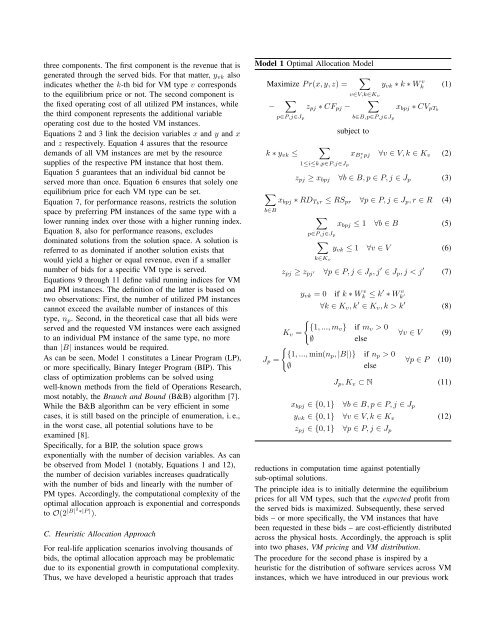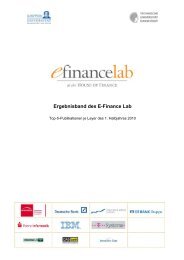Prof. Dr. Wolfgang König, Prof. Dr.-Ing. Ralf ... - E-Finance Lab
Prof. Dr. Wolfgang König, Prof. Dr.-Ing. Ralf ... - E-Finance Lab
Prof. Dr. Wolfgang König, Prof. Dr.-Ing. Ralf ... - E-Finance Lab
Create successful ePaper yourself
Turn your PDF publications into a flip-book with our unique Google optimized e-Paper software.
three components. The first component is the revenue that is<br />
generated through the served bids. For that matter, yvk also<br />
indicates whether the k-th bid for VM type v corresponds<br />
to the equilibrium price or not. The second component is<br />
the fixed operating cost of all utilized PM instances, while<br />
the third component represents the additional variable<br />
operating cost due to the hosted VM instances.<br />
Equations 2 and 3 link the decision variables x and y and x<br />
and z respectively. Equation 4 assures that the resource<br />
demands of all VM instances are met by the resource<br />
supplies of the respective PM instance that host them.<br />
Equation 5 guarantees that an individual bid cannot be<br />
served more than once. Equation 6 ensures that solely one<br />
equilibrium price for each VM type can be set.<br />
Equation 7, for performance reasons, restricts the solution<br />
space by preferring PM instances of the same type with a<br />
lower running index over those with a higher running index.<br />
Equation 8, also for performance reasons, excludes<br />
dominated solutions from the solution space. A solution is<br />
referred to as dominated if another solution exists that<br />
would yield a higher or equal revenue, even if a smaller<br />
number of bids for a specific VM type is served.<br />
Equations 9 through 11 define valid running indices for VM<br />
and PM instances. The definition of the latter is based on<br />
two observations: First, the number of utilized PM instances<br />
cannot exceed the available number of instances of this<br />
type, np. Second, in the theoretical case that all bids were<br />
served and the requested VM instances were each assigned<br />
to an individual PM instance of the same type, no more<br />
than |B| instances would be required.<br />
As can be seen, Model 1 constitutes a Linear Program (LP),<br />
or more specifically, Binary Integer Program (BIP). This<br />
class of optimization problems can be solved using<br />
well-known methods from the field of Operations Research,<br />
most notably, the Branch and Bound (B&B) algorithm [7].<br />
While the B&B algorithm can be very efficient in some<br />
cases, it is still based on the principle of enumeration, i. e.,<br />
in the worst case, all potential solutions have to be<br />
examined [8].<br />
Specifically, for a BIP, the solution space grows<br />
exponentially with the number of decision variables. As can<br />
be observed from Model 1 (notably, Equations 1 and 12),<br />
the number of decision variables increases quadratically<br />
with the number of bids and linearly with the number of<br />
PM types. Accordingly, the computational complexity of the<br />
optimal allocation approach is exponential and corresponds<br />
to O(2 |B|2 ∗|P | ).<br />
C. Heuristic Allocation Approach<br />
For real-life application scenarios involving thousands of<br />
bids, the optimal allocation approach may be problematic<br />
due to its exponential growth in computational complexity.<br />
Thus, we have developed a heuristic approach that trades<br />
Model 1 Optimal Allocation Model<br />
Maximize P r(x, y, z) = �<br />
− �<br />
p∈P,j∈Jp<br />
k ∗ yvk ≤<br />
zpj ∗ CFpj −<br />
�<br />
1≤i≤k,p∈P,j∈Jp<br />
v∈V,k∈Kv<br />
�<br />
b∈B,p∈P,j∈Jp<br />
subject to<br />
yvk ∗ k ∗ W v k<br />
xbpj ∗ CVpTb<br />
(1)<br />
xB v i pj ∀v ∈ V, k ∈ Kv (2)<br />
zpj ≥ xbpj ∀b ∈ B, p ∈ P, j ∈ Jp (3)<br />
�<br />
xbpj ∗ RDTbr ≤ RSpr ∀p ∈ P, j ∈ Jp, r ∈ R (4)<br />
b∈B<br />
Jp =<br />
�<br />
p∈P,j∈Jp<br />
�<br />
k∈Kv<br />
xbpj ≤ 1 ∀b ∈ B (5)<br />
yvk ≤ 1 ∀v ∈ V (6)<br />
zpj ≥ zpj ′ ∀p ∈ P, j ∈ Jp, j ′ ∈ Jp, j < j ′<br />
yvk = 0 if k ∗ W v k ≤ k ′ ∗ W v k ′<br />
∀k ∈ Kv, k ′ ∈ Kv, k > k ′<br />
Kv =<br />
�<br />
�<br />
{1, ..., mv}<br />
∅<br />
if mv > 0<br />
else<br />
{1, ..., min(np, |B|)} if np > 0<br />
∅ else<br />
(7)<br />
(8)<br />
∀v ∈ V (9)<br />
∀p ∈ P (10)<br />
Jp, Kv ⊂ N (11)<br />
xbpj ∈ {0, 1} ∀b ∈ B, p ∈ P, j ∈ Jp<br />
yvk ∈ {0, 1} ∀v ∈ V, k ∈ Kv (12)<br />
zpj ∈ {0, 1} ∀p ∈ P, j ∈ Jp<br />
reductions in computation time against potentially<br />
sub-optimal solutions.<br />
The principle idea is to initially determine the equilibrium<br />
prices for all VM types, such that the expected profit from<br />
the served bids is maximized. Subsequently, these served<br />
bids – or more specifically, the VM instances that have<br />
been requested in these bids – are cost-efficiently distributed<br />
across the physical hosts. Accordingly, the approach is split<br />
into two phases, VM pricing and VM distribution.<br />
The procedure for the second phase is inspired by a<br />
heuristic for the distribution of software services across VM<br />
instances, which we have introduced in our previous work








